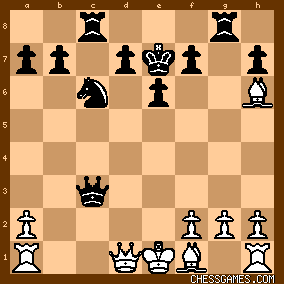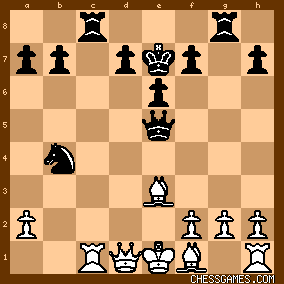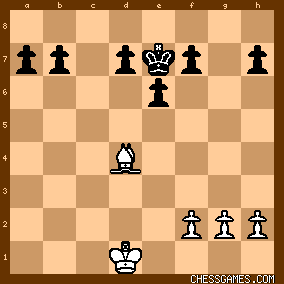KEG: Post II
In the diagrammed position with which I ended my last post, Mieses was at a cross-roads. He had two ways to proceed. He could have played 13...d5 (which Stockfish says was best) dominating the center. Alternatively, he could have--and did--play the move Fritz prefers: 13... Nxc3?!
"A very pretty move which gives Black the advantage." (Rosenthal in the Tournament Book). The text creates fascinating complications. The choice between 13...d5 and 13...Nxc3 is perhaps one of style. Given Mieses' tendency to seek sharp tactical lines, his selection here was hardly a surprise. Both moves yield a small but definite edge to Black. 14. bxN Qxc3+
15. Bd2 Qe5+
16. Be3
This left:

click for larger view16... Nb4
16...f5 was better. The text gave Mieses compensation for the sacrificed piece, but no more. 17. Rc1
The position was now:

click for larger view17... Nxa2?
Mieses was too eager to pick up a third pawn immediately for the sacrificed piece. 17...Qe4 or 17...Qe5 were both much better and sufficient for approximate equality (e.g., 17...Qa5 18. RxR Nc2+ 19. Ke2 RxR 20. Qd2 Rc3 21. Bxa7). After the text, the game swung (momentarily as it turned out) in Mason's direction. 18. RxR RxR
19. Be2 Qb2
The position now was:

click for larger view20. Qd4?
Missing the chance to exploit his two Bishops and keep an advantage with 20. Bd3. The text allowed Mieses to trade down to an even ending. Incidentally, Rosenthal's claim that 20. 0-0 Nc3 would lose for White. In fact, chances would now be equal after 21. Bg5+. 20... QxQ
He could also have played 20...Rc1+ (e.g., 21. Bd1 QxQ
22. BxQ Nc3 23. BxN RxB potentially arriving at the same position as occurred in the game). 21. BxQ Rc1+
22. Bd1 Nc3
23. Kd2
Better was 23. BxN leading to the same position as after 20...Rc1+. After the text, Mieses after the upcoming exchanges had what advantage exists. 23... RxB+
24. RxR NxR
25. KxN
This left the following fascinating endgame:

click for larger viewWhile with best play this is probably a draw, there is plenty of play remaining in the position and much of excitement still lay ahead in this game. | 




